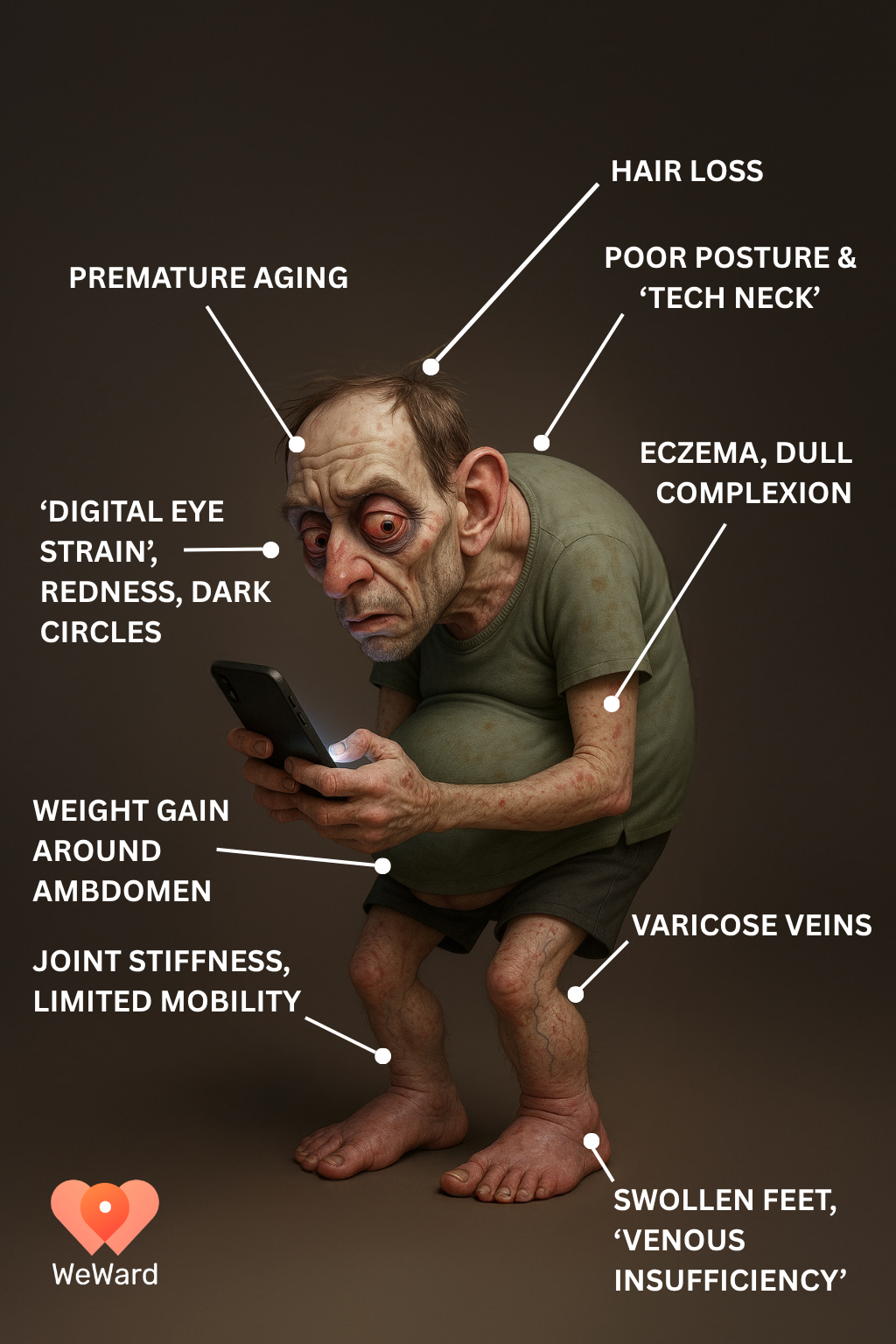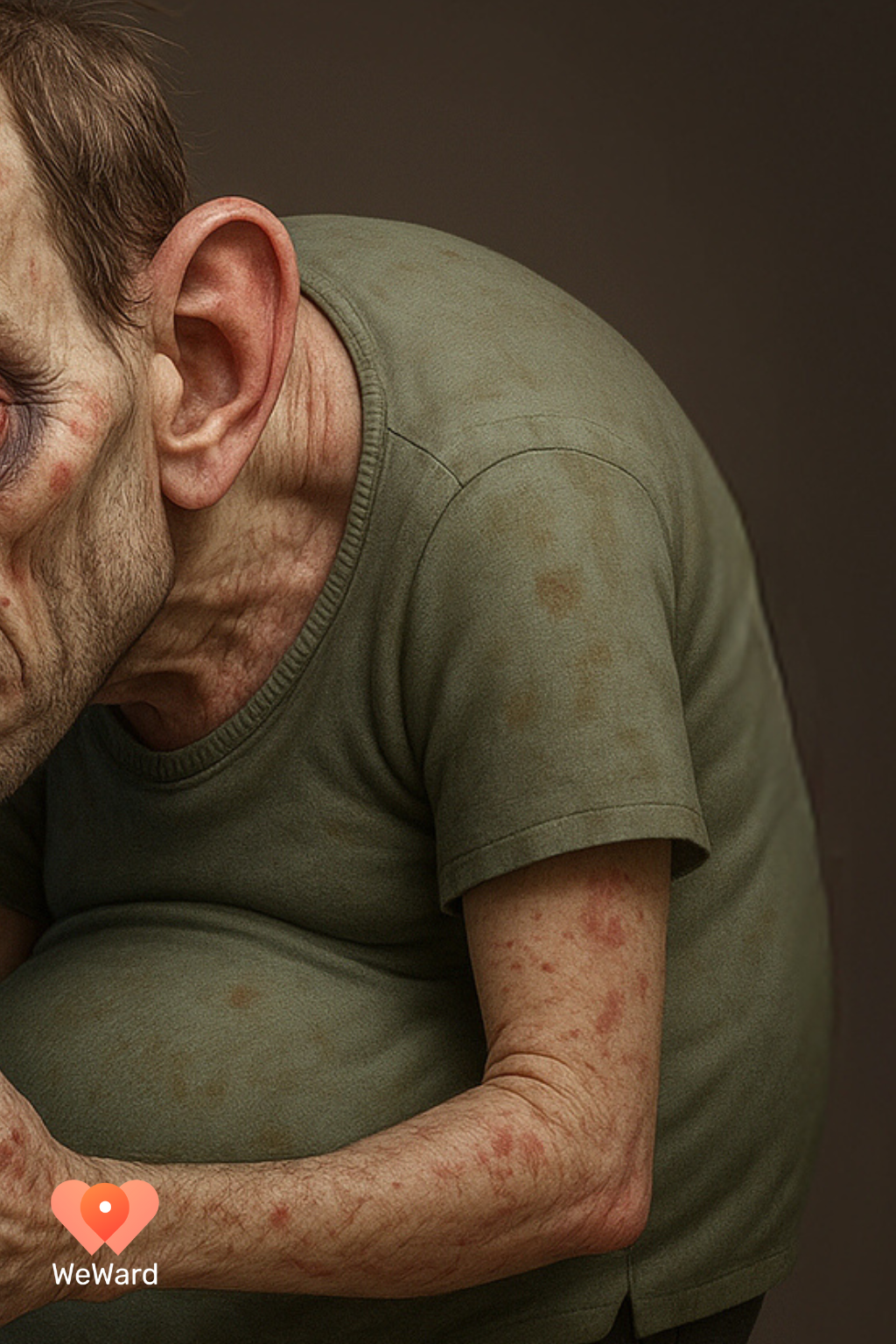To highlight the dangers of sedentary lifestyles, WeWard created Sam: a medically grounded projection of how inactivity can affect our physical appearance and overall health.
Use this ChatGPT prompt to see what your spooky future appearance could look like if you don’t start moving!
The Silent Killer Among Us
We are in the midst of one of the most overlooked public health crises of our time: the inactivity epidemic, where The World Health Organization reports that 80% of adolescents do not meet the recommended levels of physical activity.
In today’s culture of convenience, simple tasks like ordering food, taking work meetings, and connecting with friends can now happen directly from your couch. Add that to the hours spent doom-scrolling on social media, and we’re spending abnormal amounts of time sitting behind a screen. And this trend is starting early, where Backlinko found that nearly half of American teenagers have a screen time of more than 8 hours per day. Further, WeWard data shows that young adults walk nearly 15% less than older generations.
More than just a lifestyle concern, physical inactivity has very real health implications. It’s directly linked to higher risk of heart disease, stroke, diabetes, cancer, and dementia, and it also has deep effects on our day-to-day quality of life, impacting everything from sleep, to muscle and bone development, to levels of depression and anxiety.
If current trends continue, the world will fail to meet its 2030 target for reducing physical inactivity, set to cost us an estimated $300 billion in healthcare and lost productivity.
So if you’re looking for something frightening this Halloween, look no further than what could be our future if we continue to place convenience over daily movement.
Meet Sam: The Sedentary Citizen of 2050
To reveal the shocking impact of inactivity, WeWard created Sam, a visual representation of what the average sedentary person could look like by 2050. Backed by medical research, Sam illustrates the long-term physical impact and health risks that result from a life defined by limited mobility, excessive screen use, and convenience-driven habits.




Weight Gain & Increased Body Fat
When the body is inactive, it burns fewer calories and slows down your metabolism. Over time, unused energy is stored as fat, especially around the midsection, increasing the risk of obesity, diabetes, and heart disease.
Poor Posture
Spending long periods sitting or leaning over screens encourages a forward-tilting head and curved upper back, otherwise known as ‘tech neck’. This can lead to chronic neck and shoulder pain and make proper posture harder to maintain over time. Mayo Clinic Health Systems cites that neck pain in particular is the fourth leading cause of disability, with an annual prevalence rate of over 30%.
Joint Stiffness, Arthritis, and Limited Mobility
Regular movement keeps joints lubricated and flexible, but prolonged sitting disrupts this process. Without enough motion, joints can become stiff, sore, and less mobile, particularly in the hips and knees. Over time, chronic inactivity increases the chance of degenerative arthritis, as the cartilage cushioning the bones wears down, leading to swelling and lasting stiffness.
Swollen Ankles/Feet and Varicose Veins
Remaining seated for long periods slows blood flow and reduces circulation. This can cause fluids to accumulate in the ankles and feet, leading to swelling, varicose veins, and in more serious cases, increased risk of blood clots.
Premature Aging
Studies show that blue light exposure and the act of squinting into digital devices can cause signs of premature aging and hyperpigmentation to the skin.
Hair Thinning / Hair Loss
Chronic stress, poor circulation, and nutrient-poor diets, all of which are common in sedentary lifestyles, reduce oxygen and nutrients to the scalp, weakening hair follicles and accelerating thinning.
Digital Eye Strain & Blurred Vision
Excessive screen time reduces blinking and forces the eyes to focus at one distance for too long. This ultimately leads to redness, dryness, blurred vision, headaches, and difficulty focusing.
Skin Issues (Eczema, Dull Complexion, Dark Circles)
Reduced circulation means less oxygen and nutrients reach the skin, which can lead to poor vascular health. This can show up as worsened eczema flare-ups, dull complexion, and dark circles around the eyes.
Other effects not pictured:
- Higher rates of stress, anxiety, and depressive symptoms.
- Higher risk of certain cancers, including colon cancer, lung cancer, and uterine cancer.
- Higher risk of heart disease, diabetes, and hypertension.
Project Your Future Self (try this ChatGPT link)
What could this mean for you? Upload several pictures of yourself to this ChatGPT prompt to see what your spooky future appearance could look like if you don’t start moving!
WeWard also applied this projection to showcase how sedentary habits would affect some of the most famous figures in pop culture today. Recognize any of these faces?





.png)
And of course, we tried it on our very own CEO…

How To Combat Inactivity
If you’re ready to take that first step, walk with WeWard today.
Walking is the most accessible and affordable way to combat inactivity. It requires no equipment, gym membership, or learning curve, just a willingness to step outside and move. And yet, despite its profound benefits for physical and mental health, walking remains one of the most undervalued forms of preventative healthcare.
The U.S. Centers for Disease Control and Prevention recommends adults do moderate-intense physical activity for 150 minutes a week, which works out to about 30 minutes a day, five days a week. Even hitting 7,000 steps daily, a recent University of Sydney study shows, is enough to lower your risk of death by 47% and cut cardiovascular disease risk by 25%.
“I think there’s a common misperception that walking is not as good as running or cycling or swimming. You’re getting almost everything by going for a simple walk. It does a million things,” says cardiologist Dr. David Sabgir. “It reduces heart attacks, stroke, heart failure, diabetes. It reduces your blood pressure, colon cancer, lung cancer, breast cancer, osteoarthritis, anxiety and depression. It’s really a miraculous drug that affects all demographics.”
Still, knowing the science isn’t always enough to change behavior. That’s where apps like WeWard come in: we use behavioral science and a variety of financial and social-based incentives to bring the fun back into walking, and help people increase their daily activity by nearly 25%. Surveys show that many of our users start for the incentives but stay for the positive habit formations that we help build.
Fair Use disclaimer
Content from this post may be shared for non-commercial use with attribution to WeWard and a link back to this page.
Data Sources
- Nearly 1.8 billion adults at risk of disease from not doing enough physical activity, World Health Organization
- Physical Activity, World Health Organization
- Rethink the 10,000 a day step goal, study suggests, The University of Sydney
- The State of Walking Report, WeWard
- Revealing Average Screen Time Statistics, Backlinko
- Nudging sustainable mobility: an empirical analysis based on the WeWard app, Transport Policy
- Rethink the 10,000 a day step goal, study suggests, The University of Sydney
- Adult Activity: An Overview, CDC
- Health Risks of Inactive Lifestyle, Medline Plus
- Increased walking can Lessen Depression, UCLA Health
- Daily Step Count and Depression in Adults, Jama Open Network
- The Impact of Blue Light and Digital Screens on the Skin, PubMed
- How Does Decreased Mobility Contribute to Peripheral Edema in the Feet?, Medical Advisory Board
- ‘Tech neck’: Technology’s Effect On Your Neck, Mayo Clinic Health System
- What a Sedentary Lifestyle Can Do To Your Health, Cleveland Clinic
- The Dangers of Sitting: Why Sitting is the New Smoking, Better Health Channel
- How Vascular Health Affects Your Skin: Why Circulation Matters for a Healthy Glow, Laser Vascular Center
- Digital Devices and Your Eyes, American Academy of Ophthalmology
.svg)
.svg)
.svg)





.png)

